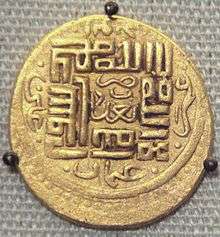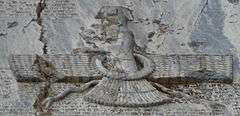Jalairid Sultanate
The Jalairids were a Mongol Jalayir dynasty which ruled over Iraq and western Persia after the breakup of the Mongol khanate of Persia in the 1330s.[3] The Jalairid sultanate lasted about fifty years, until disrupted by Timur's conquests and the revolts of the Kara Koyunlu ("Black Sheep") Turkmen.[4] After Timur's death in 1405, there was a brief attempt to re-establish the sultanate in southern Iraq and Khuzistan. The Jalairids were finally eliminated by the Kara Koyunlu in 1432.
Jalayirid Sultanate | |||||||||
|---|---|---|---|---|---|---|---|---|---|
| 1335–1432 | |||||||||
Division of Ilkhanate territory | |||||||||
| Capital | |||||||||
| Common languages | |||||||||
| Government | Monarchy | ||||||||
| History | |||||||||
• Established | 1335 | ||||||||
• Disestablished | 1432 | ||||||||
| |||||||||
| Today part of | |||||||||

Jalairid coinage, Baghdad, 1382-1387.
Government
The Jalairid administration and chancellery was modeled after Ilkhanate protocols, with documents in Persian and Mongolian.[2] Their diplomatic correspondence also copied the Ilkhanate's, using a red ink square seal with Islamic phrases in Arabic.[2]
Rulers
| Title/Name[5] | Personal name | Reign |
|---|---|---|
| Taj-ud-Din تاج الدین |
Hasan Buzurg | 1336–1356 |
| Mu'izz-ud-duniya wa al-Din معزالدنیا والدین Bahadur Khan بهادرخان |
Shaikh Awais Jalayir | 1356–1374 |
| Jalal-ud-Din جلال الدین |
Shaikh Hasan Jalayir | 1374 |
| Ghiyas-ud-Din غیاث الدین |
Shaikh Hussain Jalayir | 1374–1382 |
| Shaikh Bayazid Jalayir Ruler of Iraq-i 'Ajam at Soltaniyeh and contender for the throne |
1382–1384 | |
| Sultan سلطان |
Sultan Ahmed Jalayir Ruler of Iraq-i 'Arab at Baghdad and contender for the throne |
1382–1410 |
| Shah Walad Jalayir son of Shaikh Ali Jalayir |
1410–1411 | |
| Sultan سلطان |
Mahmud bin Shah Walad Jalayir under tutelage of Tandu Khatun |
1411 (1st reign) |
| Sultan سلطان |
Awais bin Shah Walad Jalayir | 1411–1421 |
| Sultan سلطان |
Muhammad bin Shah Walad Jalayir | 1421 |
| Sultan سلطان |
Mahmud bin Shah Walad Jalayir | 1421–1425 (2nd reign) |
| Hussain bin Ala-ud-Daulah bin Sultan Ahmed Jalayir | 1425–1432 | |
Family tree
| Husein Gurkan | daughter of Arghun | ||||||||||||||||||||||||||||||||||||||||
| Hasan Buzurg 1336–1356 | Dilshad Khatun | ||||||||||||||||||||||||||||||||||||||||
| Uvais I 1356–1374 | |||||||||||||||||||||||||||||||||||||||||
| Alishah | Husain I 1374–1382 | Ahmad 1383–1410 | Hasan 1374 | ||||||||||||||||||||||||||||||||||||||
| Shah Valad 1410–1411 | Tandura Khatun | Al'a od-Dowleh | |||||||||||||||||||||||||||||||||||||||
| Mahmud 1411–1415 | Uvais II 1415–1421 | Mohammed 1421–1422 | Husain II 1424–1432 | ||||||||||||||||||||||||||||||||||||||
gollark: I might try implementing RLE to compress URLs even further.
gollark: Amateur.
gollark: Still doesn't make sense.
gollark: Is this some memeemem I don't understand?
gollark: What?
See also
References
- Jackson, edited by Peter; Lockhart, the late Laurence (1986). The Cambridge History of Iran, Volume 6: The Timurid and Safavid periods (Repr ed.). Cambridge: New York. p. 978. ISBN 0521200946.CS1 maint: extra text: authors list (link)
- Broadbridge, Anne F. Kingship and Ideology in the Islamic and Mongol Worlds, (Cambridge University Press, 2008), 157.
- Bayne Fisher, William. The Cambridge History of Iran, p.3: "From then until Timur's invasion of the country, Iran was under the rule of various rival petty princes of whom henceforth only the Jalairids could claim Mongol lineage"
- The History Files Rulers of Persia
- Bosworth, Clifford Edmund. The new Islamic dynasties: a chronological and genealogical manual. New Edinburgh Islamic Surveys Series; ISBN 0-7486-2137-7, 978-0-7486-2137-8
Further reading
- Wing, Patrick. (2016). The Jalayirids: Dynastic State Formation in the Mongol Middle East. Edinburgh: Edinburgh University Press. ISBN 978-1-4744-2637-4
External links
- Jackson, Peter (2008). "JALAYERIDS". Encyclopaedia Iranica, Vol. XIV, Fasc. 4. pp. 415–419.CS1 maint: ref=harv (link)
This article is issued from Wikipedia. The text is licensed under Creative Commons - Attribution - Sharealike. Additional terms may apply for the media files.
